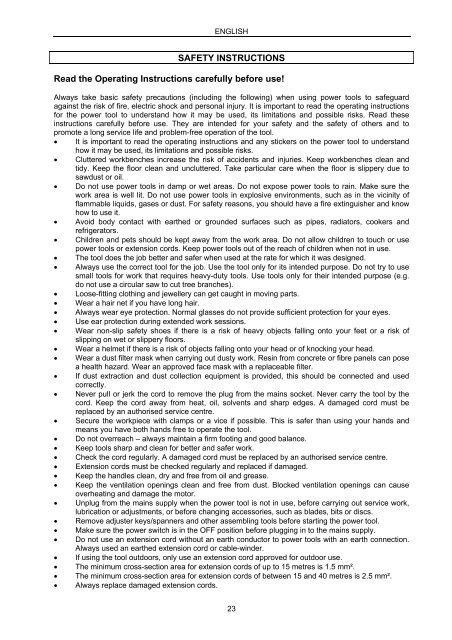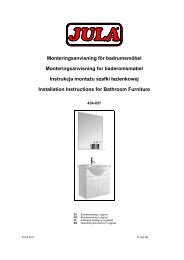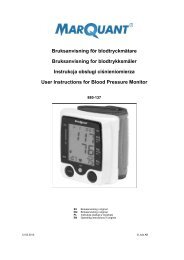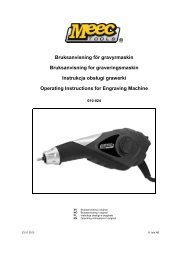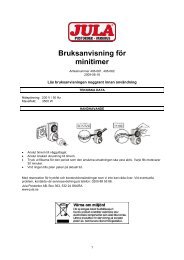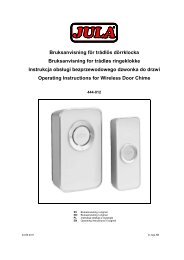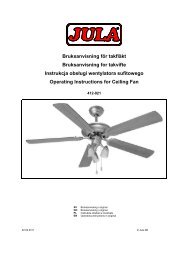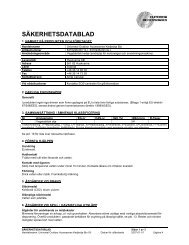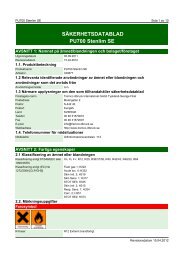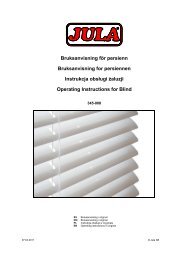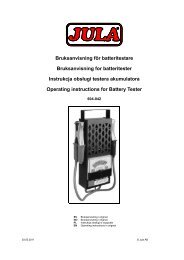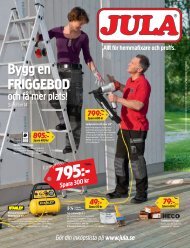Bruksanvisning för vinkelslip 230 mm Bruksanvisning for ... - Jula
Bruksanvisning för vinkelslip 230 mm Bruksanvisning for ... - Jula
Bruksanvisning för vinkelslip 230 mm Bruksanvisning for ... - Jula
You also want an ePaper? Increase the reach of your titles
YUMPU automatically turns print PDFs into web optimized ePapers that Google loves.
ENGLISH<br />
ENGLISH<br />
SAFETY INSTRUCTIONS<br />
Read the Operating Instructions carefully be<strong>for</strong>e use!<br />
Always take basic safety precautions (including the following) when using power tools to safeguard<br />
against the risk of fire, electric shock and personal injury. It is important to read the operating instructions<br />
<strong>for</strong> the power tool to understand how it may be used, its limitations and possible risks. Read these<br />
instructions carefully be<strong>for</strong>e use. They are intended <strong>for</strong> your safety and the safety of others and to<br />
promote a long service life and problem-free operation of the tool.<br />
It is important to read the operating instructions and any stickers on the power tool to understand<br />
how it may be used, its limitations and possible risks.<br />
Cluttered workbenches increase the risk of accidents and injuries. Keep workbenches clean and<br />
tidy. Keep the floor clean and uncluttered. Take particular care when the floor is slippery due to<br />
sawdust or oil.<br />
Do not use power tools in damp or wet areas. Do not expose power tools to rain. Make sure the<br />
work area is well lit. Do not use power tools in explosive environments, such as in the vicinity of<br />
fla<strong>mm</strong>able liquids, gases or dust. For safety reasons, you should have a fire extinguisher and know<br />
how to use it.<br />
Avoid body contact with earthed or grounded surfaces such as pipes, radiators, cookers and<br />
refrigerators.<br />
Children and pets should be kept away from the work area. Do not allow children to touch or use<br />
power tools or extension cords. Keep power tools out of the reach of children when not in use.<br />
<br />
<br />
<br />
<br />
<br />
<br />
<br />
<br />
<br />
<br />
<br />
<br />
<br />
<br />
<br />
<br />
<br />
<br />
<br />
<br />
<br />
<br />
<br />
<br />
<br />
<br />
The tool does the job better and safer when used at the rate <strong>for</strong> which it was designed.<br />
Always use the correct tool <strong>for</strong> the job. Use the tool only <strong>for</strong> its intended purpose. Do not try to use<br />
small tools <strong>for</strong> work that requires heavy-duty tools. Use tools only <strong>for</strong> their intended purpose (e.g.<br />
do not use a circular saw to cut tree branches).<br />
Loose-fitting clothing and jewellery can get caught in moving parts.<br />
Wear a hair net if you have long hair.<br />
Always wear eye protection. Normal glasses do not provide sufficient protection <strong>for</strong> your eyes.<br />
Use ear protection during extended work sessions.<br />
Wear non-slip safety shoes if there is a risk of heavy objects falling onto your feet or a risk of<br />
slipping on wet or slippery floors.<br />
Wear a helmet if there is a risk of objects falling onto your head or of knocking your head.<br />
Wear a dust filter mask when carrying out dusty work. Resin from concrete or fibre panels can pose<br />
a health hazard. Wear an approved face mask with a replaceable filter.<br />
If dust extraction and dust collection equipment is provided, this should be connected and used<br />
correctly.<br />
Never pull or jerk the cord to remove the plug from the mains socket. Never carry the tool by the<br />
cord. Keep the cord away from heat, oil, solvents and sharp edges. A damaged cord must be<br />
replaced by an authorised service centre.<br />
Secure the workpiece with clamps or a vice if possible. This is safer than using your hands and<br />
means you have both hands free to operate the tool.<br />
Do not overreach – always maintain a firm footing and good balance.<br />
Keep tools sharp and clean <strong>for</strong> better and safer work.<br />
Check the cord regularly. A damaged cord must be replaced by an authorised service centre.<br />
Extension cords must be checked regularly and replaced if damaged.<br />
Keep the handles clean, dry and free from oil and grease.<br />
Keep the ventilation openings clean and free from dust. Blocked ventilation openings can cause<br />
overheating and damage the motor.<br />
Unplug from the mains supply when the power tool is not in use, be<strong>for</strong>e carrying out service work,<br />
lubrication or adjustments, or be<strong>for</strong>e changing accessories, such as blades, bits or discs.<br />
Remove adjuster keys/spanners and other assembling tools be<strong>for</strong>e starting the power tool.<br />
Make sure the power switch is in the OFF position be<strong>for</strong>e plugging in to the mains supply.<br />
Do not use an extension cord without an earth conductor to power tools with an earth connection.<br />
Always used an earthed extension cord or cable-winder.<br />
If using the tool outdoors, only use an extension cord approved <strong>for</strong> outdoor use.<br />
The minimum cross-section area <strong>for</strong> extension cords of up to 15 metres is 1.5 <strong>mm</strong>².<br />
The minimum cross-section area <strong>for</strong> extension cords of between 15 and 40 metres is 2.5 <strong>mm</strong>².<br />
Always replace damaged extension cords.<br />
23


